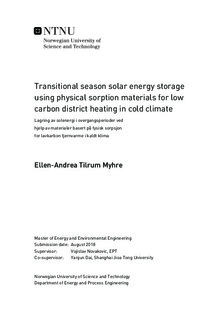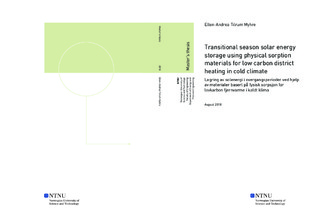| dc.description.abstract | The aim of the work with this thesis has been to acquire enough knowledge about solar energy and thermochemical storage systems to build a mathematical model of a theoretical system located in Beijing, China, and further test the model for a second theoretical case located in Trondheim, Norway.
A basic presentation of the solar potential and solar energy technology is included to introduce an understanding of the sun s potential as renewable source and how it can be utilized. A simplified method of dimensioning a solar collector system along with a description of the available stationary solar collectors is also presented.
While thermochemical energy storage is the main focus of this thesis, it also includes an explanation of the two other types of thermal energy storage; sensible and latent energy storage. The focus is further limited to thermochemical energy storage using sorption, with a special focus on seasonable storage. The purpose of the storage is to improve the general efficiency of the solar collector system by limiting the disparity between supply and demand. As thermochemical energy storage has a higher energy capacity and requires lower volumes, it has through literature studied been regarded as the best alternative between the available options of thermal energy storage. However, the technology is currently only in its research phase and will require more effort to optimize the working materials and components before it can be realized commercially.
The goal of the assignment is met by presenting a complete mathematical model for a 100 m2 domestic household in Beijing, China. The model of the seasonal sorption storage using silica gel is functioning for the dimensioning parameters of the Beijing climate, and is successfully tested for the case located in Trondheim. Through simulations, the importance of correct water content, relative humidity and charging temperature became apparent. Results show that the model is able to store 0.089 kW/kg water while meeting the outlet temperature requirement of 35°C, but that the energy demand and water content heavily affects the necessary volume and size. | |

